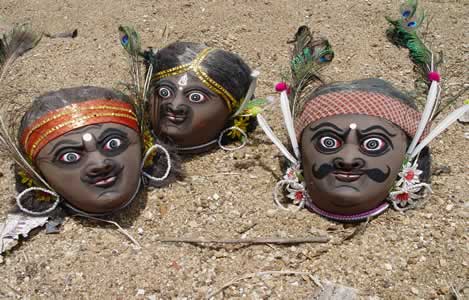


Tribal Art of Jharkhand

Copyright © visitindia.org.in 2011-12. All Rights Reserved.
More info on Jharkhand
Masterpieces in clay
The soil of Jharkhand is particularly suited to the needs of the artist and the craftsmen. So one can see the clay figures of elephants, pots, jugs, masks of various variety, rural motifs, and so on. During festival season idol craftsmen from Bengal flock to Jharkhand to make their brand of artistry in the form of idols like Durga, Kali, Saraswati and other deities from bamboo, straw, colours, tinsel, pith and other decorations. The 'painted mask', tradition of Jharkhand is truly legendary. In early days, masks were made of leaves, but today highly stylized masks use a variety of materials like wood, pumpkin, gourd, cloth, even paper mache. Masks are intrinsic to the outstanding folk dance form known as Chhau, in Jharkhand. Collectors items can be mythological masks, animal masks, and those with various facial expressions.
Creations in metal
Dokra the ancient metal craft which interested the worldwide artistic community is practised by the Malhar and Tentri tribes of Jharkhand. Created from brass scrap the objects have a core of clay concealed in a metal casing. Hand crafted, intricately worked figurines, village tableaux, drummers, elephants, oil lamps etc are their creative masterpieces. No Dokra sculpture is an exact duplicate of the other - each one is authentic and original. Many beautiful products from black metal or the traditional 'kansa' or bell metal with a matt block finish on the outside and shiny golden finish on the inside are made here.
Tribal Jewellery crafted in gold, silver or white metal are seen. Wide bracelets called choor in a spectacular design range, large conical tops bala and tarpat earings with flat worked chains that go over the ears are some traditional items. Popular are a string of three chains with a flower-shaped clasp or heart shaped filigree clasp at both ends. large heart-shaped hair clips called tara kata and paan kata are worn in pairs. Mandli chokers with simple half-moons strung on black thread and designed to fit snugly on the throat come with matching earings. Hasli, the thick plain choker dipped in gold features tribal graphics etched into its surface. Bead necklaces are even popular. 'Kanghee' combs are wonderful items for use and decor. Wood axes with tribal motifs burnt into their handles are collectors items, nut found in almost any weekly haat or village bazaar.
Upturned bowl shaped umbrellas of cane are used in the feilds but can be used in any garden. Finely carved door panels, wood inlay boxes, wooden crosses and Virgin Mary figures with the crown of throrns in wood are crafted in villages like Khunti.
Tribal theme toys and carvings, like a band of drummers, ancient bird-women, statues of tribal leaders like Birsa Munda etc can be a collectors delight.
Wood
Bamboo is sculpted into door panels, boxes, spoons, hunting and fishing equipment, rice huskers and bowls smeared with pink and leaf green powder on ritual occasions. "Pattal" plates and bowls made from the Sal leaves are widely used during wedding and other festivities. "Sabai ghaas" or wild grass is woven into bowls, pen-stands, coasters and mats, or dyed and woven into intricate and colourful boxes, dolls, table mats and christmas tree decorations. Chaibasa region is famous for these.
Small villages around Ranchi have for decorations created finger painted toys from palm leaves, some detachable limbs and wheels for mobility. They also make toys on the wedding of Lord Rama, parakeets with red beaks and green feathers.
Paintings
Oraon comb cut paintings can be traced to the ancient times. Images of cattle, birds, fishes, geometric figures, arches are the common designs. Ganju art forms characterize animals wild and domesticated and plants. Endangered animals are often depicted in picture-story tradition.
Prajapati, Rana & Teli
The three sub castes decorate their homes with plant amd animal fertility forms using both finer painting and comb cutting techniques. The 'prajapati' style uses filigree work, with emphasis on zoomorphic plant representations.
Kurmi
is a unique style of sahrai, where drawing outlines are scratched onto the surface of a wall with nails and a wooden compass is used to etch the segmented lotus. pashupati or Lord Shiva is depicted as a horned deity on the back of a bull. Red, black and white lines are drawn in pairs on either side to represent the sahes of the ancestors.
Munda
use their fingers to paint in the soft, wet earth of their homes and use unique motifs like rainbow snake and plant form of deities.
Ghatwals
use glyptic paintings of animals on their forest dwelling.
Birhor & Bhuiya
use simple, strong and authentic graphic forms like 'mandalas' painting with their fingers. Crescents, stars, yoni, rectangles with corner petals, concentric circles etc are very common.
Manjhi Santhal
the striking warring figures painted in black on simple clay plaster walls are startling remainders that their origins had probable links with the Indus Valley Civilization.
